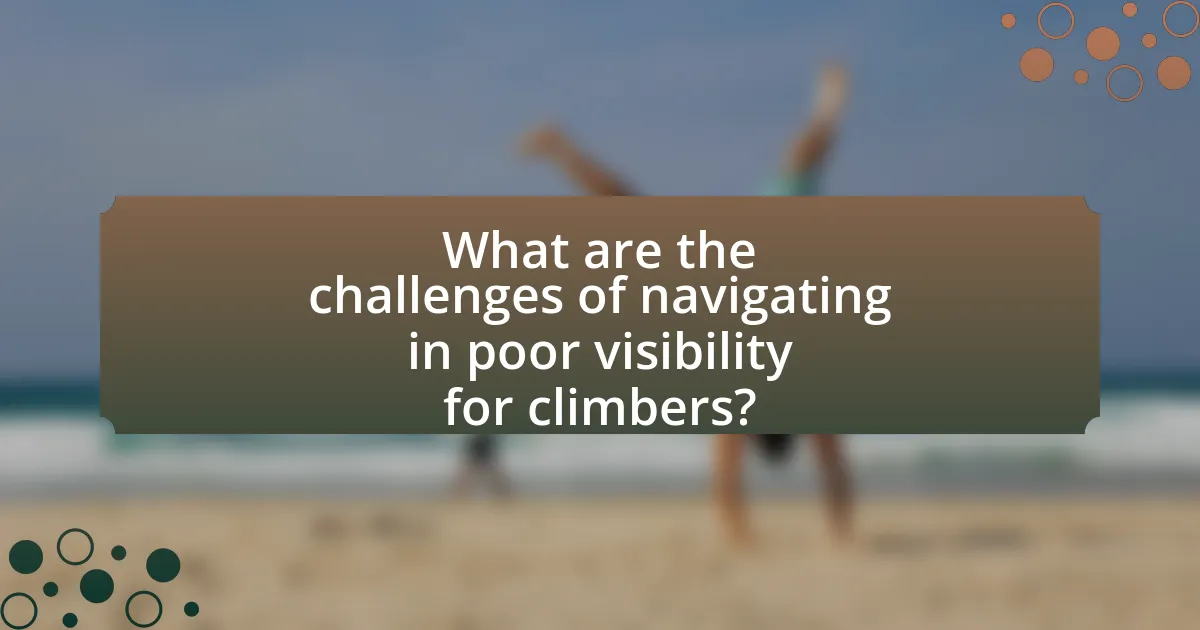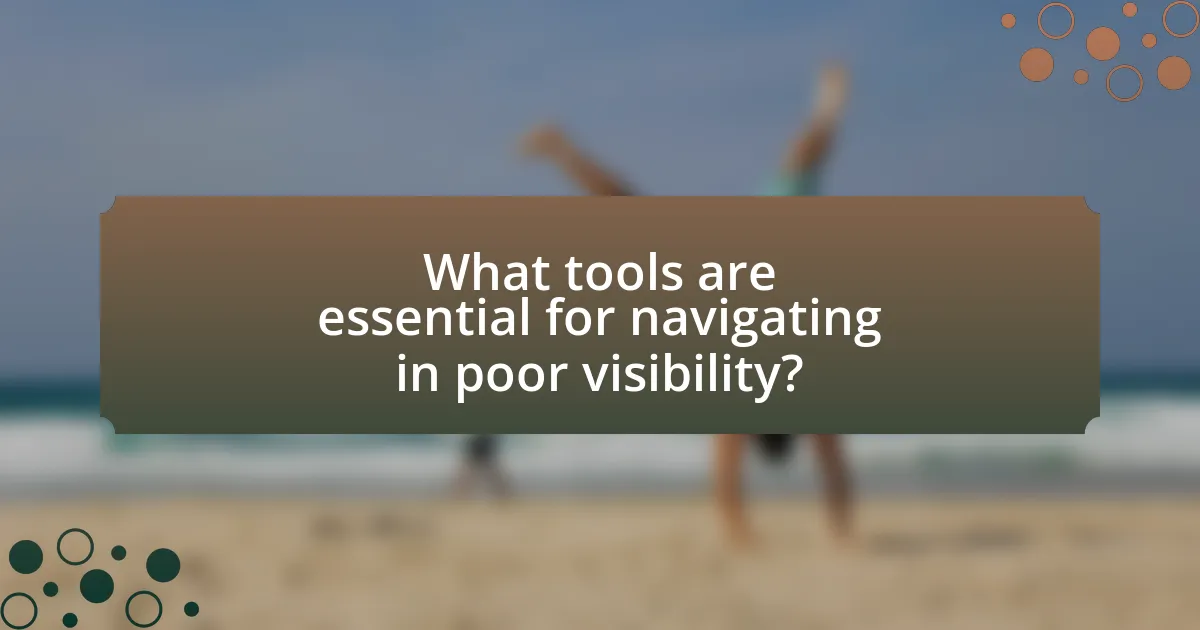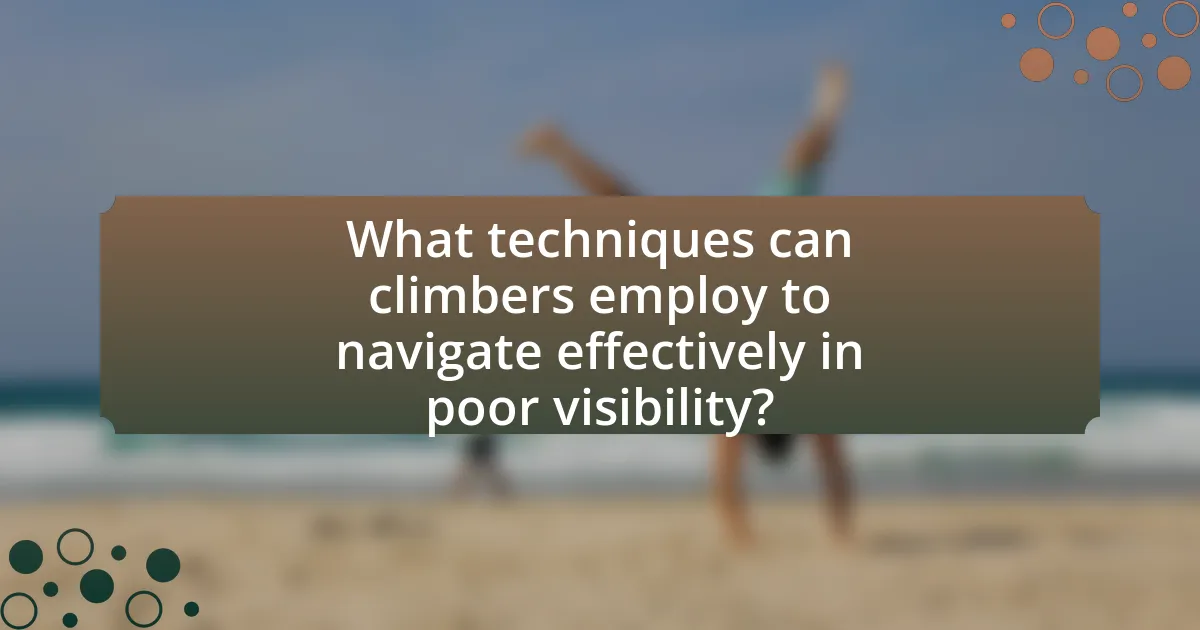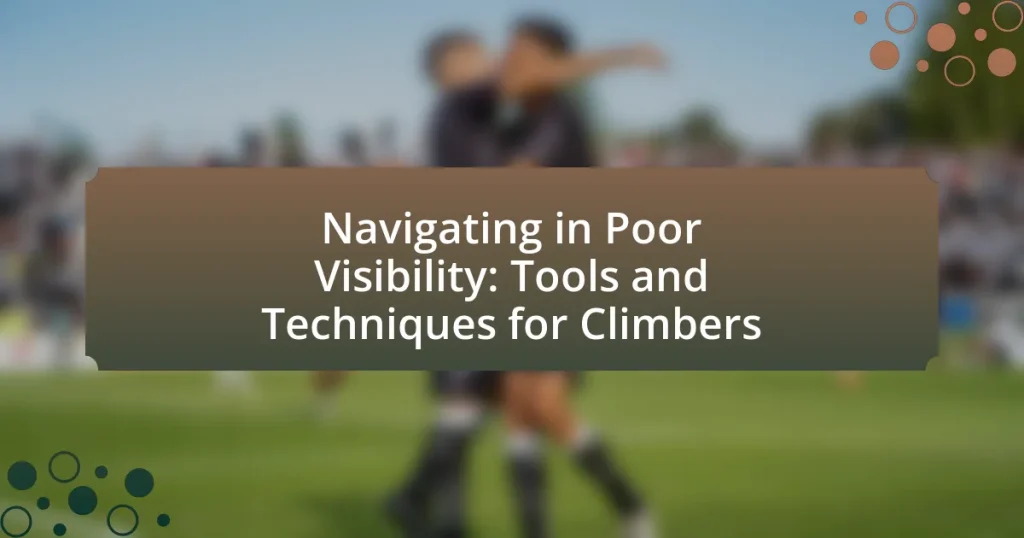Navigating in poor visibility is a critical concern for climbers, as it significantly impacts safety and increases the risk of accidents due to disorientation and navigation errors. Climbers face specific challenges such as misjudging distances, failing to identify hazards, and losing track of their routes, particularly in adverse weather conditions like fog, rain, or snow. Essential tools for effective navigation include compasses, GPS devices, and topographic maps, which enhance situational awareness and decision-making. Additionally, climbers can employ various techniques and strategies, such as maintaining communication, using auditory cues, and practicing navigation skills, to mitigate risks associated with low visibility. Understanding these factors is crucial for ensuring safety and successful navigation in challenging climbing environments.

What are the challenges of navigating in poor visibility for climbers?
Navigating in poor visibility presents significant challenges for climbers, primarily due to reduced spatial awareness and increased risk of disorientation. Climbers often rely on visual cues for route finding, and when visibility is compromised, they may struggle to identify landmarks or follow established paths. This can lead to increased chances of getting lost or making dangerous decisions, such as attempting to traverse unstable terrain. Additionally, poor visibility can hinder the ability to assess weather conditions, which is crucial for safety in climbing environments. Studies indicate that over 30% of climbing accidents occur due to navigational errors, underscoring the critical nature of visibility in ensuring climber safety.
How does poor visibility affect climbing safety?
Poor visibility significantly compromises climbing safety by increasing the risk of accidents and navigation errors. When climbers cannot see their surroundings clearly, they may misjudge distances, fail to identify hazards, or lose track of their route, leading to falls or getting lost. Research indicates that visibility conditions can reduce a climber’s ability to assess terrain features, which is critical for safe decision-making. For instance, a study published in the Journal of Outdoor Recreation and Tourism highlights that climbers in low visibility conditions are more likely to experience disorientation and accidents, emphasizing the importance of proper navigation tools and techniques in such situations.
What specific risks do climbers face in low visibility conditions?
Climbers face several specific risks in low visibility conditions, including increased chances of falling, disorientation, and difficulty in navigation. The lack of visibility can lead to misjudgment of distances and terrain, resulting in falls from ledges or steep areas. Disorientation occurs as climbers struggle to maintain their bearings, which can lead to getting lost or straying from established routes. Additionally, navigation becomes challenging without visual cues, increasing the likelihood of encountering hazardous conditions or obstacles. These risks are supported by studies indicating that visibility directly impacts climber safety, with incidents of accidents rising significantly in foggy or snowy conditions.
How can poor visibility lead to navigation errors?
Poor visibility can lead to navigation errors by impairing a climber’s ability to accurately identify landmarks and terrain features. When visibility is reduced due to fog, rain, or darkness, climbers may struggle to discern their surroundings, which increases the likelihood of misjudging distances and directions. Studies indicate that navigation errors in low visibility conditions can result in a 30% increase in the likelihood of getting lost, as climbers may rely more heavily on unreliable cues or instruments. This reliance can lead to incorrect route choices and ultimately jeopardize safety.
What environmental factors contribute to poor visibility?
Environmental factors that contribute to poor visibility include fog, heavy rain, snow, and smoke. Fog can reduce visibility to less than 100 meters, significantly impacting navigation. Heavy rain can create water droplets that scatter light, leading to decreased clarity. Snowfall can obscure landmarks and create whiteout conditions, where the horizon disappears. Smoke from wildfires or pollution can also limit visibility by creating a haze that obstructs sight. These conditions are critical for climbers to consider, as they can affect safety and navigation during outdoor activities.
How do weather conditions impact visibility during climbs?
Weather conditions significantly impact visibility during climbs by affecting atmospheric clarity and light conditions. For instance, fog, rain, or snow can reduce visibility to a few meters, making it difficult for climbers to navigate and assess their surroundings. Studies have shown that low visibility conditions can increase the risk of accidents, as climbers may struggle to identify routes or obstacles. Additionally, overcast skies can diminish natural light, further complicating visibility. Therefore, understanding and anticipating weather conditions is crucial for climbers to ensure safety and effective navigation.
What role does terrain play in visibility challenges?
Terrain significantly impacts visibility challenges by obstructing sightlines and creating shadows. For instance, mountainous or heavily wooded areas can block direct views, making it difficult for climbers to navigate or identify landmarks. Additionally, uneven terrain can lead to varying light conditions, such as areas of bright sunlight contrasted with deep shadows, further complicating visibility. Studies have shown that in environments with complex terrain, such as the Rocky Mountains, visibility can be reduced by up to 50% compared to open areas, highlighting the critical role terrain plays in navigation and safety for climbers.
What psychological effects can poor visibility have on climbers?
Poor visibility can lead to heightened anxiety and decreased confidence among climbers. When climbers cannot see their surroundings clearly, they may experience fear of the unknown, which can impair decision-making and increase the likelihood of errors. Research indicates that anxiety can negatively affect cognitive functions, such as attention and memory, making it difficult for climbers to focus on their route or assess risks effectively. Additionally, poor visibility can create a sense of isolation, further exacerbating feelings of stress and uncertainty, which can hinder performance and increase the risk of accidents.
How does fear influence decision-making in low visibility?
Fear significantly impacts decision-making in low visibility by heightening anxiety and leading to risk-averse behaviors. In situations where visibility is compromised, individuals often experience increased uncertainty, which can trigger a fight-or-flight response. This response may cause climbers to overestimate risks and underestimate their abilities, resulting in overly cautious decisions, such as avoiding necessary movements or delaying progress. Research indicates that fear can impair cognitive functions, leading to a narrowed focus on immediate threats rather than a broader assessment of the environment. For instance, a study published in the Journal of Experimental Psychology found that fear can limit the ability to process information effectively, which is crucial for making informed decisions in challenging conditions.
What strategies can climbers use to manage anxiety in these conditions?
Climbers can manage anxiety in poor visibility conditions by employing techniques such as focused breathing, visualization, and maintaining a steady pace. Focused breathing helps regulate heart rate and calm the mind, while visualization allows climbers to mentally rehearse their route and anticipate challenges, reducing uncertainty. Maintaining a steady pace prevents overwhelming feelings and promotes a sense of control. Research indicates that these strategies can effectively reduce anxiety levels, as evidenced by studies showing that controlled breathing and mental imagery improve performance and decrease stress in high-pressure situations.

What tools are essential for navigating in poor visibility?
Essential tools for navigating in poor visibility include compasses, GPS devices, and altimeters. Compasses provide directional guidance, allowing climbers to maintain their intended route despite limited sight. GPS devices offer precise location tracking and route planning, which is crucial when visual landmarks are obscured. Altimeters help climbers determine their elevation, assisting in navigation by correlating altitude with topographical maps. These tools collectively enhance safety and accuracy in challenging conditions, as evidenced by their widespread use in outdoor navigation and mountaineering practices.
How do navigation tools enhance safety for climbers?
Navigation tools enhance safety for climbers by providing accurate positioning and route guidance, which reduces the risk of getting lost in challenging environments. These tools, such as GPS devices, compasses, and topographic maps, allow climbers to track their location in real-time, ensuring they remain on designated paths and avoid hazardous areas. For instance, a study published in the Journal of Outdoor Recreation and Tourism highlights that climbers using GPS technology significantly decreased their chances of disorientation and accidents in low-visibility conditions. By facilitating informed decision-making and enabling quick responses to changing weather or terrain, navigation tools are essential for maintaining climber safety.
What types of compasses are best suited for low visibility conditions?
The best types of compasses suited for low visibility conditions are digital compasses and compasses with luminescent features. Digital compasses provide precise directional readings and often include backlighting, making them easier to read in dark or foggy environments. Compasses with luminescent features, such as those with glow-in-the-dark dials or illuminated needles, enhance visibility in low light. These features are crucial for climbers navigating challenging conditions, as they allow for accurate navigation without relying solely on visual cues.
How can GPS devices assist climbers in poor visibility?
GPS devices assist climbers in poor visibility by providing precise location data and navigation capabilities. These devices utilize satellite signals to determine the climber’s exact position, allowing them to track their route and avoid hazards even when visual landmarks are obscured. For instance, GPS units often include features like waypoints and tracks, enabling climbers to set specific points of interest and follow pre-planned routes, which is crucial in conditions where visibility is limited. Additionally, many GPS devices offer topographic maps and elevation data, further aiding climbers in understanding their surroundings and making informed decisions about their ascent or descent.
What role do maps play in navigation during low visibility?
Maps serve as essential tools for navigation during low visibility by providing a reliable reference for terrain features, routes, and distances. In conditions such as fog, heavy rain, or darkness, visual cues become limited, making maps crucial for maintaining orientation and planning safe paths. For instance, topographic maps indicate elevation changes and landmarks, which help climbers identify their location and navigate effectively even when sight is impaired. Additionally, maps can be used in conjunction with compasses or GPS devices to enhance accuracy, ensuring climbers can make informed decisions about their route despite environmental challenges.
How can climbers effectively use topographic maps in challenging conditions?
Climbers can effectively use topographic maps in challenging conditions by focusing on key features such as contour lines, elevation changes, and landmarks. These elements help climbers understand the terrain and navigate accurately even when visibility is low. For instance, contour lines indicate the steepness of slopes, allowing climbers to anticipate difficult sections and plan their route accordingly. Additionally, identifying prominent landmarks on the map can serve as reference points, aiding in orientation and decision-making. Studies show that climbers who regularly practice map reading and terrain association improve their navigation skills, which is crucial in adverse weather conditions.
What are the advantages of digital maps over traditional ones?
Digital maps offer several advantages over traditional maps, particularly in navigation during poor visibility conditions. Firstly, digital maps provide real-time updates and dynamic information, allowing users to access the latest data on terrain, weather, and obstacles. This is crucial for climbers who may face rapidly changing conditions. Additionally, digital maps often include GPS functionality, enabling precise location tracking and route planning, which enhances safety and efficiency in navigation. Furthermore, digital maps can be easily zoomed in and out, providing detailed views of specific areas, which is not possible with static traditional maps. These features collectively improve navigational accuracy and decision-making for climbers in challenging environments.
What additional gear can improve navigation in low visibility?
Additional gear that can improve navigation in low visibility includes GPS devices, compasses, and headlamps. GPS devices provide precise location data and can function in low light conditions, enhancing route planning and tracking. Compasses offer reliable directional guidance, essential for maintaining orientation when visibility is compromised. Headlamps illuminate the path ahead, allowing climbers to read maps or navigate terrain effectively in darkness or fog. These tools collectively enhance safety and navigation accuracy in challenging conditions.
How do headlamps and flashlights contribute to safer navigation?
Headlamps and flashlights enhance safer navigation by providing focused illumination in low-light conditions, allowing climbers to see obstacles and terrain features clearly. This visibility reduces the risk of accidents, such as tripping or falling, which can occur in dark environments. Studies show that adequate lighting significantly improves spatial awareness and decision-making, crucial for climbers navigating challenging paths. For instance, a study published in the Journal of Outdoor Recreation and Tourism highlights that proper lighting equipment decreases the likelihood of navigation errors in poor visibility scenarios.
What clothing and accessories can enhance visibility for climbers?
Brightly colored clothing and reflective accessories can significantly enhance visibility for climbers. Wearing high-visibility colors such as neon yellow, orange, or pink allows climbers to stand out against natural backgrounds, especially in low-light conditions. Additionally, incorporating reflective materials in jackets, helmets, and backpacks increases visibility during dusk or dawn. Studies show that bright colors and reflective gear can improve detection rates by up to 70% in poor visibility conditions, making them essential for safety in climbing environments.

What techniques can climbers employ to navigate effectively in poor visibility?
Climbers can employ techniques such as using a compass, GPS devices, and topographic maps to navigate effectively in poor visibility. A compass allows climbers to maintain a sense of direction even when visual landmarks are obscured. GPS devices provide precise location data, which is crucial for determining one’s position and planning routes. Topographic maps offer detailed information about the terrain, helping climbers identify elevation changes and potential hazards. These tools, when used together, enhance navigational accuracy and safety in challenging conditions.
How can climbers develop their navigation skills for low visibility?
Climbers can develop their navigation skills for low visibility by practicing the use of compasses, GPS devices, and map reading techniques in various conditions. Regularly engaging in navigation drills that simulate low visibility scenarios enhances their ability to orient themselves and make quick decisions. Studies show that climbers who frequently train in challenging environments improve their situational awareness and decision-making skills, which are crucial for navigating safely. Additionally, familiarizing themselves with terrain features and practicing route planning before heading out can significantly aid in navigation when visibility is compromised.
What are the best practices for using a compass in challenging conditions?
The best practices for using a compass in challenging conditions include ensuring a clear line of sight to landmarks, regularly checking for magnetic interference, and using a map in conjunction with the compass. Maintaining a steady grip on the compass and keeping it level helps improve accuracy. In environments with poor visibility, such as fog or heavy snow, it is crucial to take multiple bearings and triangulate positions to confirm direction. Additionally, understanding declination adjustments is essential, as local magnetic variations can affect readings. These practices enhance navigation reliability, especially in unpredictable terrains.
How can climbers practice navigation techniques before facing poor visibility?
Climbers can practice navigation techniques before facing poor visibility by utilizing map and compass exercises in varied terrain. Engaging in these exercises helps climbers develop skills in reading topographic maps, understanding compass bearings, and estimating distances, which are crucial for navigation in low-visibility conditions. Research indicates that regular practice enhances spatial awareness and decision-making abilities, allowing climbers to respond effectively when visibility decreases. Additionally, simulating poor visibility conditions during training, such as using blindfolds or navigating in fog, can further reinforce these skills and prepare climbers for real-life scenarios.
What strategies can be used to maintain orientation in low visibility?
To maintain orientation in low visibility, climbers can utilize techniques such as compass navigation, GPS devices, and auditory cues. Compass navigation allows climbers to determine their direction based on magnetic north, which is crucial when visual landmarks are obscured. GPS devices provide precise location data, enabling climbers to track their route and position even in fog or heavy snowfall. Additionally, auditory cues, such as the sound of flowing water or wind direction, can help climbers orient themselves relative to their surroundings. These strategies are supported by the fact that many outdoor navigation courses emphasize the importance of using multiple tools to ensure safety and accuracy in challenging conditions.
How can climbers use landmarks to aid navigation in fog or snow?
Climbers can use prominent landmarks to aid navigation in fog or snow by relying on their visibility and distinct features to maintain orientation. Landmarks such as mountain peaks, rock formations, or unique vegetation can serve as reference points, helping climbers to establish their position and direction. For instance, studies have shown that climbers often memorize the locations of these landmarks during clear conditions, allowing them to navigate effectively even when visibility is compromised. By cross-referencing their compass readings with the known positions of these landmarks, climbers can make informed decisions about their route, reducing the risk of getting lost in challenging weather conditions.
What is the importance of pacing and timing in navigation?
Pacing and timing are crucial in navigation as they directly influence a climber’s ability to maintain a safe and efficient route in poor visibility conditions. Proper pacing ensures that climbers can manage their energy levels and avoid fatigue, which is essential for making sound decisions and maintaining focus. Timing is equally important, as it helps climbers estimate their progress and adjust their plans based on changing environmental conditions, such as weather or daylight. Research indicates that climbers who effectively manage their pacing and timing are less likely to encounter dangerous situations, as they can better anticipate challenges and respond accordingly.
What are the best practices for climbing in poor visibility?
The best practices for climbing in poor visibility include using reliable navigation tools, maintaining communication with climbing partners, and ensuring proper gear is utilized. Climbers should rely on GPS devices, compasses, and maps to navigate effectively, as visibility can hinder visual cues. Maintaining communication through radios or pre-established signals is crucial for safety and coordination. Additionally, climbers should wear appropriate gear, such as headlamps or reflective clothing, to enhance visibility and ensure they can be seen by others. These practices are supported by climbing safety guidelines, which emphasize the importance of preparation and awareness in challenging conditions.
How can climbers ensure effective communication in low visibility conditions?
Climbers can ensure effective communication in low visibility conditions by utilizing pre-established signals and technology such as two-way radios. Establishing a set of hand signals or verbal cues before the climb allows team members to convey essential information without visual confirmation. Additionally, using two-way radios enhances communication over distances where visibility is compromised, as they allow for real-time updates and coordination. Studies indicate that teams employing these methods report higher safety and efficiency in challenging conditions, demonstrating their effectiveness in maintaining communication.
What should climbers do if they become disoriented in low visibility?
Climbers who become disoriented in low visibility should stop, assess their situation, and avoid making any sudden movements. This approach minimizes the risk of accidents and allows climbers to regain their bearings. They should use a map and compass or GPS device to determine their location and direction. If these tools are unavailable, climbers can retrace their steps to a known point or seek shelter until visibility improves. Staying calm and conserving energy is crucial, as panic can lead to poor decision-making.
What tips can climbers follow to enhance their navigation skills in poor visibility?
Climbers can enhance their navigation skills in poor visibility by utilizing a combination of reliable tools and techniques. First, they should always carry a map and compass, as these traditional navigation tools do not rely on visibility and can provide accurate bearings. Additionally, climbers should familiarize themselves with the terrain before the climb, noting key landmarks and potential hazards, which aids in orientation even when visibility is compromised.
Using a GPS device can also be beneficial; however, climbers must ensure it is fully charged and that they understand how to use it effectively. Practicing navigation skills in various conditions, including low visibility scenarios, helps climbers build confidence and competence. Furthermore, maintaining a steady pace and using consistent reference points can assist in keeping track of their route.
Lastly, climbers should communicate their plans and expected routes with their team, ensuring everyone is aware of navigation strategies, which enhances group safety and coordination. These methods are supported by outdoor navigation guidelines that emphasize preparation and adaptability in challenging conditions.
